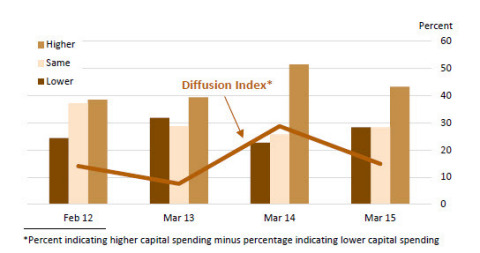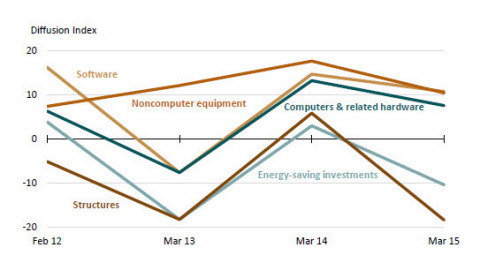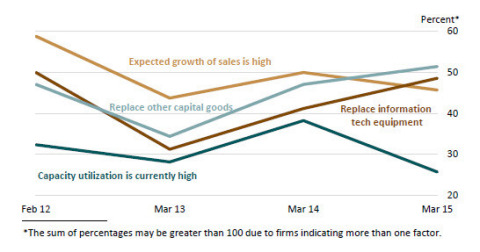PHILADELPHIA--(BUSINESS WIRE)--Manufacturing activity in the region increased at a modest pace in March, according to firms responding to this month’s Manufacturing Business Outlook Survey. The survey’s current indicators for general activity and new orders were positive and remained near their low readings in February. Firms reported overall declines in shipments and in work hours, while overall employment increased only slightly. Firms reported more widespread price reductions in March, although most firms continued to report steady prices. The survey's indicators of future activity showed mixed results but continued to suggest that the manufacturing sector is expected to continue growing over the next six months.
Indicators Suggest Modest Growth
The survey’s broadest measure of manufacturing conditions, the diffusion index of current activity, at 5.0, was virtually unchanged from its reading of 5.2 in February. The demand for manufactured goods, as measured by the current new orders index, remained at a very low, albeit positive, reading of 3.9 and edged 2 points lower than in February. The current shipments index fell more dramatically (16 points) and returned the index to negative territory (its second negative reading in three months). Firms reported faster delivery times and a decrease in unfilled orders this month compared with February.
Firms’ responses suggest weaker labor market conditions compared with most of last year. Although the current employment index, at just 3.5, was virtually unchanged from last month, the index remains well below its average reading of about 14 over the second half of last year. The percentage of firms reporting an increase in employees in March (17 percent) narrowly exceeded the percentage reporting a decrease (14 percent). Firms also reported reductions in the workweek in March: The percentage of firms reporting a shorter workweek (24 percent) was greater than the percentage reporting a longer workweek (13 percent).
Share of Firms Reporting Price Reductions Has Increased
Input price pressures continued to moderate for reporting manufacturers: The prices paid index fell 8 points to -3.0 in March, its first negative reading since the summer of 2009. Although most firms (68 percent) reported that input prices were unchanged, the percentage of firms reporting price reductions (17 percent) exceeded those reporting increases (14 percent). With respect to prices received for manufactured goods, the percentage of firms reporting price reductions (17 percent) exceeded those reporting price increases (10 percent). The prices received index fell 6 points to -6.4, its third consecutive negative reading. The largest percentage of firms (71 percent) reported no change in manufactured goods prices.
Most Future Indicators Remain Positive but Are at Lower Levels Than Last Year
The diffusion index for future activity edged up from 29.7 to 32.0 but remained lower than readings over the past year. The future indexes for new orders and shipments, however, moved in the opposite direction, falling 9 points and 6 points, respectively. The future employment index also was weaker this month. The future employment index decreased 12 points, to its lowest reading since April 2013. Although nearly 57 percent of the firms are expecting no change in their employment levels over the next six months, the percentage expecting increases in employment (25 percent) remained greater than the percentage expecting decreases (11 percent).
In this month’s special questions, firms were surveyed about capital spending plans for 2015 compared with actual levels in 2014. These questions were asked for the last four years.
Summary
The Manufacturing Business Outlook Survey suggests continued modest expansion of the region’s manufacturing sector in March. The indicators for general activity and new orders both continued to suggest modest growth. Firms reported an overall reduction in shipments and average labor hours for March. Respondents also indicated that downward price pressures continued for inputs. Also, for their own products, more firms reported price decreases than reported price increases. Firms remain optimistic about increases in overall business and employment over the next six months, although optimism was less widespread than just a few months ago.
|
MANUFACTURING |
March vs. February |
Six Months from Now vs. March |
||||||||||||||||||
|
Previous |
Increase |
No |
Decrease |
Diffusion |
Previous |
Increase |
No |
Decrease |
Diffusion |
|||||||||||
| What is your evaluation of the level of general business activity? | 5.2 | 27.2 | 47.7 | 22.2 | 5.0 | 29.7 | 42.5 | 37.9 | 10.5 | 32.0 | ||||||||||
| Company Business Indicators | ||||||||||||||||||||
| New Orders | 5.4 | 29.8 | 44.4 | 25.9 | 3.9 | 42.8 | 47.1 | 30.9 | 12.8 | 34.3 | ||||||||||
| Shipments | 8.1 | 24.6 | 43.0 | 32.4 | -7.8 | 38.2 | 47.9 | 30.0 | 15.7 | 32.3 | ||||||||||
| Unfilled Orders | 7.3 | 9.5 | 63.7 | 23.3 | -13.8 | 7.9 | 19.6 | 58.2 | 11.0 | 8.7 | ||||||||||
| Delivery Times | -4.6 | 7.7 | 68.0 | 21.1 | -13.4 | -0.2 | 13.0 | 64.3 | 11.1 | 1.9 | ||||||||||
| Inventories | 15.2 | 19.5 | 53.5 | 21.8 | -2.3 | 0.0 | 14.0 | 56.4 | 14.6 | -0.6 | ||||||||||
| Prices Paid | 4.7 | 14.2 | 67.7 | 17.3 | -3.0 | 32.2 | 31.1 | 56.4 | 3.7 | 27.5 | ||||||||||
| Prices Received | -0.2 | 10.2 | 71.3 | 16.5 | -6.4 | 19.3 | 20.0 | 59.4 | 12.6 | 7.4 | ||||||||||
| Number of Employees | 3.9 | 17.2 | 67.1 | 13.8 | 3.5 | 26.8 | 25.1 | 56.6 | 10.7 | 14.4 | ||||||||||
| Average Employee Workweek | -6.0 | 12.5 | 59.8 | 23.9 | -11.4 | 14.1 | 7.9 | 68.1 | 12.2 | -4.2 | ||||||||||
| Capital Expenditures | -- | -- | -- | -- | -- | 20.9 | 32.4 | 44.7 | 16.0 | 16.4 | ||||||||||
|
NOTES: |
||||||||||||||||||||
|
(1) Items may not add up to 100 percent because of omission by respondents. |
||||||||||||||||||||
|
(2) All data are seasonally adjusted. |
||||||||||||||||||||
|
(3) Diffusion indexes represent the percentage indicating an increase minus the percentage indicating a decrease. |
||||||||||||||||||||
|
(4) Survey results reflect data received through March 17, 2015. |
||||||||||||||||||||




